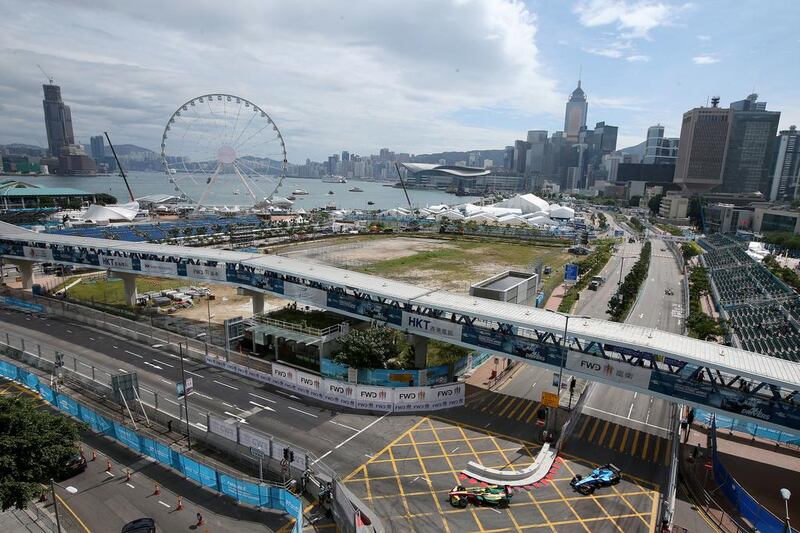Twenty open-wheeled racers line up on the grid. The lights go green, and the cars sprint from their starting slots and jostle for position as they charge towards the first corner. All fairly typical of a motor race, but there are two things missing: the eardrum-assaulting thunder of fuel combustion and hazy residue being spat out of exhaust pipes.
Welcome to Formula E. I’m at the inaugural Hong Kong ePrix – a 45-lap dash around a tight, two-kilometre street circuit in the heart of the Central Victoria Harbour area. It’s the first time the Far Eastern metropolis has hosted Formula E, and the event is the maiden round of the 2016-17 championship.
It’s my first Formula E experience, and my curiosity about what the cars sound like is immediately answered as a soundtrack that’s akin to a radio-controlled car – albeit amplified 100-fold or so – accompanies each car as it swishes past. Perhaps meant as a compensatory measure, loudspeakers scattered around the circuit blast out upbeat music for the duration of the race.
The Formula E championship is in its third year, and is rapidly gaining strength – factory-backed teams from Renault, Audi and BMW have now been joined by Jaguar, while Mercedes is poised to jump into the fray in 2018. The reason why these car manufacturers are signing up is best summed up by Lucas di Grassi, the Audi driver who finished second in last year’s championship and won the first-ever ePrix in 2014: “Motorsport reflects what manufacturers want to promote. Electric cars will become the norm in the future, while combustion engines will become niche.”
What Formula E represents for these automotive brands is a high-intensity research-and-development arena in which they can innovate and test new electric-power-train tech in the heat of battle. The front-running teams also gain credibility in the eyes of the public by proving that their technology is at the cutting edge of what’s out there. Tesla has got a jump on the major manufacturers by proving there are already plenty of willing buyers for battery-powered cars, as long as said vehicles deliver an attractive equation in terms of performance, practicality and price.
Jaguar has thus far shunned the hybrid and full-electric genre, but it’s now playing catch-up, and the company’s product engineering boss, Nick Rogers, says the company’s push into Formula E is a reflection of what’s to come from the brand. Among the vehicles believed to be in the leaping cat pipeline are an all-electric SUV derived from the F-Pace, and this will reportedly take the fight to the Tesla Model X.
Panasonic Jaguar racing director James Barclay says: “Formula E is an international championship that is moving into the bullseye of where the automotive industry is heading. We felt that was really important to choose a form of motor racing that was moving more into that bullseye, but would also give us the true learning from a racetrack perspective to apply the technology to our road cars.”
Although the hardware – motor, inverter and transmission – used by the team’s Formula E racer are quite different to that used by Jaguar’s upcoming electric road cars, Barclay says there are valuable lessons to learn in terms of how to optimise the performance of each of these components, and also in the area of managing the heat issues associated with large battery packs. This know-how could be directly applied to the company’s production cars, he says.
It’s this applicability to the mass market that has also prompted Michelin to favour Formula E over Formula One. It uses a single tyre type (with tread) regardless of conditions, whereas F1 cars have three different compounds for dry weather, plus separate wet and intermediate rubber. For all intents and purposes, a Formula E tyre looks like something you could affix to your road car and use to pass an inspection at the RTA. The same certainly doesn’t apply to an F1 slick tyre.
Some quick stats for the sake of perspective: Formula E racers are propelled by electric motors that generate a maximum output of 270hp; the cars weigh 880 kilograms, including the driver. By comparison, F1 cars push out 750-850hp and weigh 702kg with the driver in situ. The battery-powered racers are no match for F1 cars in terms of pure pace, but that’s not to say they don’t make for an exciting spectacle. On the contrary, there’s plenty of wheel-banging dices, and the Hong Kong race is punctuated by several desperate overtaking moves, with drivers diving into corners two or three abreast.
The Formula E pilots have a twin-pronged challenge. They must not only try to outpace their competitors, but they also have to do so while managing their energy consumption to avoid draining their batteries prematurely. The rules are set up so each driver jumps out of one car and into another, with fully charged batteries, halfway through the race, and the sprint for the chequered flag is then on again. As a spectator, you can keep track of the percentage of battery charge each driver has remaining, and it’s fascinating to see how they strategically use the e-juice available as they race to the chequered flag.
Packed grandstands in Hong Kong (tickets apparently sold out within an hour of going on sale) are an indicator that Formula E is a hit with the public. What adds to the accessibility of the sport is that races are held in the heart of the city – made possible by the fact the cars generate little noise and zero emissions – so there’s no need for fans to make the trek to a far-flung racetrack. In many regards, it seems to be the future.
motoring@thenational.ae





